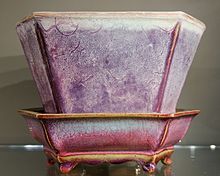


Jun ware (Chinese: 鈞窯; pinyin: Jūn yáo; Wade–Giles: Chün-yao) is a type of Chinese pottery, one of the Five Great Kilns of Song dynasty ceramics. Despite its fame, much about Jun ware remains unclear, and the subject of arguments among experts. Several different types of pottery are covered by the term, produced over several centuries and in several places, during the Northern Song dynasty (960–1127), Jin dynasty (1115–1234) and Yuan dynasty (1271–1368), and (as has become clearer in recent years) lasting into the early Ming dynasty (1368–1644).[1]
Some of the wares were for a popular market, especially the drinking vessels, but others seem to have been made for the imperial court and are known as "official Jun wares"; they are not mentioned in contemporary documents and their dating remains somewhat controversial. These are mostly bowls for growing bulbs or flower-pots with matching stands, such as can be seen in many paintings of scenes in imperial palaces.[2] The consensus that seems to be emerging, driven largely by the interpretation of excavations at kiln sites, divides Jun wares into two groups: a large group of relatively popular wares made in simple shapes from the Northern Song to (at lower quality) the Yuan, and a much rarer group of official Jun wares made at a single site (Juntai) for the imperial palaces in the Yuan and early Ming periods.[3] Both types rely largely for their effect on their use of the blue and purple glaze colours; the latter group are sturdy shapes for relatively low-status uses such as flowerpots and perhaps spitoons.[4]
The most striking and distinctive Jun wares use blue to purple glaze colours, sometimes suffused with white, made with straw ash in the glaze.[5] They often show "splashes" of purple on blue, sometimes appearing as though random, though they are usually planned. A different group are "streaked" purple on blue,[6] the Chinese describing the streaks as "worm-tracks". This is a high-prestige stoneware which was greatly admired and often imitated in later periods. But colours range from a light greenish-brown through green to blue and purple. The shapes are mostly simple, except for the official wares, and other decoration is normally limited to the glaze effects.[7] Most often, the "unofficial" wares are wheel-thrown, but the official ones moulded.
The wares are stoneware in terms of Western classification, and "high-fired" or porcelain in Chinese terms (where the class of stoneware is not generally recognised). Like the still more prestigious Ru ware, they are often not quite fired as high as the normal stoneware temperature range, and the body remains permeable to water.[8] They form a "close relative" of the wider group of Northern celadons or greenwares.[9]